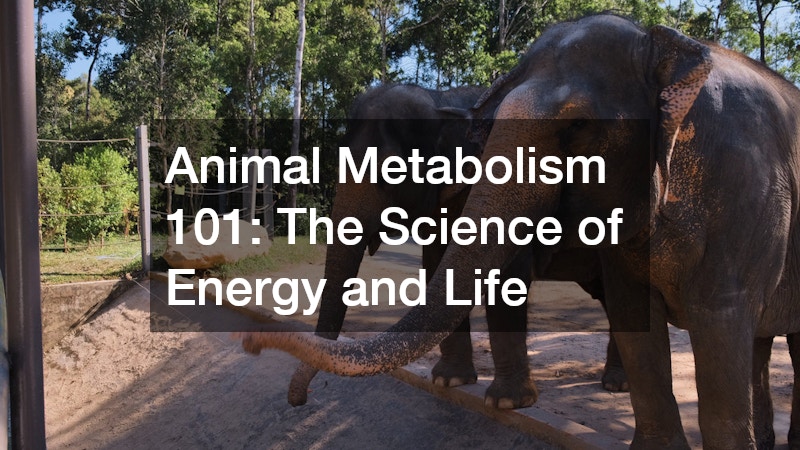
Understanding animal metabolism is crucial for appreciating how animals, including humans, obtain and utilize energy necessary for survival. This complex yet fascinating topic encompasses the biochemical processes vital for maintaining life. Metabolism varies across species, influenced by factors like diet, environment, and physical activity.
Despite these differences, the core principles of metabolism remain consistent, providing insight into the life-sustaining mechanisms present in animals. This article will guide you through the fundamental concepts of animal metabolism, exploring how these processes convert food into energy, how they differ among species, and their role in health and disease.
The Basics of Animal Metabolism
At its core, animal metabolism involves the chemical reactions that occur within cells to sustain life. These reactions are categorized into two pathways: catabolism and anabolism. Catabolism refers to the breakdown of complex molecules to release energy, while anabolism involves the synthesis of complex molecules from simpler ones, consuming energy in the process. Together, they form a balanced system that ensures organisms can grow, repair tissues, and respond to environmental changes. Without metabolism, animals would be unable to fuel the essential processes required for survival.
The energy currency used in metabolic processes is primarily adenosine triphosphate (ATP). ATP is produced through various metabolic pathways, including glycolysis, the Krebs cycle, and oxidative phosphorylation. Glycolysis is the initial step where glucose is broken down in the cytoplasm, yielding ATP and pyruvate. The Krebs cycle further processes pyruvate in the mitochondria, generating electron carriers that facilitate ATP production through oxidative phosphorylation. This intricate cascade ensures that animals efficiently convert nutrients into usable energy.
Environmental factors significantly influence metabolic rates in animals. For instance, ectothermic animals like reptiles rely on external temperatures to regulate their metabolism, in contrast to endothermic animals, such as mammals, which maintain a constant internal temperature. This adaptation allows endotherms to sustain high levels of activity, albeit with a higher energy cost. In extreme environments, some species, like the Arctic ground squirrel, exhibit altered metabolic states, such as hibernation, to conserve energy. These adaptations highlight the dynamic nature of animal metabolism and its critical role in survival.
Differentiation in Metabolic Rates Among Species
Animal metabolism varies widely across species due to evolutionary adaptations that optimize energy use for survival in specific ecological niches. Birds, for example, possess exceptionally high metabolic rates, which support their energy-intensive flight capability. Conversely, large mammals like elephants have slower metabolic rates due to their massive body size, which conserves energy more efficiently. These metabolic differences are not only fascinating but also critical for understanding the evolutionary trade-offs that shape animal physiology. Consequently, studying these variations provides insights into the diverse strategies animals employ to thrive in their respective habitats.
Metabolic rate is commonly measured by an animal’s basal metabolic rate (BMR), which reflects the energy expenditure required to maintain basic physiological functions at rest. Factors such as body size, age, sex, and reproductive status influence BMR. Smaller animals typically have higher BMRs per unit body weight compared to larger animals, due to a higher surface area-to-volume ratio and increased energy demands for thermoregulation. Additionally, a metabolic concept known as Kleiber’s law describes the relationship between body size and metabolic rate, illustrating the profound impact of size on energy dynamics. This law underscores the importance of size as a factor in the metabolic costs of different animal species.
The Role of Metabolism in Health and Disease
Animal metabolism plays a pivotal role in health and disease, impacting growth, reproduction, and overall survival. Metabolic disorders, such as diabetes and obesity, highlight the critical importance of metabolic regulation. These conditions often arise from imbalances in energy intake and expenditure, leading to excessive or insufficient body fat. In the animal kingdom, metabolic disorders can affect wild and domesticated species alike, influencing their ability to thrive in their environments. Understanding the intricacies of animal metabolism helps researchers develop preventive and therapeutic strategies to address these health challenges.
Nutrient availability and diet are central to metabolic health. Carnivores, herbivores, and omnivores have evolved distinct metabolic pathways optimized for their specific diets. For instance, herbivores have specialized digestive systems that facilitate the breakdown of fibrous plant material, whereas carnivores possess enzymatic adaptations for protein and fat digestion. These dietary specializations underscore the importance of metabolism in aligning nutritional intake with physiological requirements. Feeding strategies, therefore, play a crucial role in maintaining metabolic balance and supporting an organism’s life processes.
Emerging research continues to unveil the complex interactions between metabolism and other biological systems. The gut microbiome, for example, is increasingly recognized for its influence on metabolic health, impacting nutrient absorption and energy regulation. In-depth studies of these interactions offer valuable insights into the holistic nature of metabolism, revealing its role in immune function, inflammation, and even behavior. By deepening our understanding of animal metabolism, scientists and veterinarians can better address the multifaceted challenges of health and disease in the animal world.

